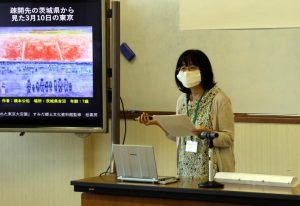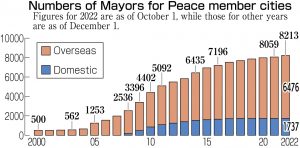Transcending national borders—Prior to General Conference of Mayors for Peace, Part 1: Taking memories of war personally
Oct. 18, 2022
by Kana Kobayashi and Fumiyasu Miyano, Staff Writers
The Mayors for Peace organization was established 40 years ago, with the aim of paving the way for the abolition of nuclear weapons by connecting cities and citizens across national borders. That union of cities born during the Cold War and connected by the desire for peace is increasing in intensity amid a growing international crisis marked by threats of nuclear weapons’ use for the third occasion in wartime. Is achieving a world free of nuclear weapons and war possible through the solidarity of civil society? Prior to the General Conference of Mayors for Peace, a gathering that will kick off on October 19, the Chugoku Shimbun examines the challenges facing the organization.
“I heard my father’s voice saying, ‘It’s different this time. Wake up.’ I put on an air-raid hood and rushed outside.” That excerpt is from an account about devastation from the Great Tokyo Air Raid that was recounted by a resident of Kunitachi City who had experienced the attack in downtown Tokyo. On October 1, the closing ceremony of a seminar for training legacy successors, who pass on the war experiences of others to following generations, was held at Tokyo’s Kunitachi City Hall. Chieko Sawamura, 62, a resident of Ome City, Tokyo, who had successfully completed the training as one of the successors of the war experience, vividly described to around 20 attendees the scenes of the devastation she had learned from the Kunitachi City resident.
Not limited to Hiroshima
Kunitachi City joined the Mayors for Peace organization in 2010. Following the lead of Hiroshima, Kunitachi City launched its own A-bomb legacy successor project in 2015, with the aim of having third parties pass on A-bomb survivors’ testimonies of their experiences. Incorporating the local experiences of people during the air raid in Tokyo, the program has thus far trained 32 legacy successors. The trainees are being dispatched to elementary and junior high schools to communicate such stories of others’ experiences.
Kunitachi City Mayor Kazuo Nagami said, “If such legacy-successor activities were limited to only the A-bombed cities, that would not help foster a world free of nuclear weapons.” He asserted that efforts to not only learn the horrific consequences of the atomic bombings but also to confront memories of the war for member cities in their own areas is necessary to create a community and society in which citizens can feel at a personal level the devastation caused by the war.” With relatives who died in the atomic bombing of Hiroshima, Ms. Sawamura said, “To prevent war, I’m hoping to pass on to children the detailed thoughts and feelings of those who have experienced war.”
The Mayors for Peace organization, launched in June 1982, has in Japan 1,737 member cities, wards, towns, and villages, which is 99.8% of the country’s localities. Globally, membership totals 8,213 cities from 166 countries and regions (all figures as of October 1, 2022). Since 2003, the time of compilation of the “2020 Vision,” a set of guidelines aimed at the total elimination of nuclear weapons by 2020, membership has increased significantly from the 562 members at that time. With the increased membership, the organization has strengthened its impact on international politics by dint of its sheer numbers.
Even if plan is presented
Nevertheless, while membership has steadily risen, there is variance in the level of activities carried out by the member cities and regions. Kunitachi City is representative of the cities that work with a sense of enthusiasm. According to the Hiroshima Peace Culture Foundation, the organization’s secretariat located in the city’s Naka Ward, only 95 cities have reported having held in the last five years an A-bombing poster exhibit, which is one of the goals proposed in the organization’s action plan.
An official from a member city in Yamaguchi Prefecture admitted, “Our city has done nothing in particular.” The official said, “We were simply presented with an action plan. If the secretariat were to ask us specifically to do something, we’d look into whether to conduct that particular activity.”
In an effort to raise participation awareness among member cities, the organization’s secretariat started asking for a voluntary annual membership fee of 2,000 yen in fiscal 2015. However, the payment rate of the membership fee in fiscal 2021 was less than 20 percent of all member cities. Payment by overseas member cities was less than 10 percent, while that by member cities in Japan was 60 percent. An official from a member city in the Chugoku region that has never paid the membership fee explained the city’s reasoning for its lack of payment. “With limited financial resources, we work to carefully determine our budget in a way that will not directly impact citizens,” said the official.
In July 2021, based on the “PX Vision,” the successor to the 2020 Vision, the Mayors for Peace set the promotion of a culture of peace in civil society as its main goal. Keiko Nakamura, associate professor of nuclear disarmament at the Research Center for Nuclear Weapons Abolition of Nagasaki University (RECNA), pointed out that “more concrete measures should be presented to encourage member cities to put the vision into practice.” She added, “Russia’s invasion of Ukraine has heightened the sense of crisis over the use of nuclear weapons. Efforts that connect with familiar issues as well as with the current international situation are important.”
(Originally published on October 18, 2022)
The Mayors for Peace organization was established 40 years ago, with the aim of paving the way for the abolition of nuclear weapons by connecting cities and citizens across national borders. That union of cities born during the Cold War and connected by the desire for peace is increasing in intensity amid a growing international crisis marked by threats of nuclear weapons’ use for the third occasion in wartime. Is achieving a world free of nuclear weapons and war possible through the solidarity of civil society? Prior to the General Conference of Mayors for Peace, a gathering that will kick off on October 19, the Chugoku Shimbun examines the challenges facing the organization.
Membership numbers continue to increase, but activities are uneven
“I heard my father’s voice saying, ‘It’s different this time. Wake up.’ I put on an air-raid hood and rushed outside.” That excerpt is from an account about devastation from the Great Tokyo Air Raid that was recounted by a resident of Kunitachi City who had experienced the attack in downtown Tokyo. On October 1, the closing ceremony of a seminar for training legacy successors, who pass on the war experiences of others to following generations, was held at Tokyo’s Kunitachi City Hall. Chieko Sawamura, 62, a resident of Ome City, Tokyo, who had successfully completed the training as one of the successors of the war experience, vividly described to around 20 attendees the scenes of the devastation she had learned from the Kunitachi City resident.
Not limited to Hiroshima
Kunitachi City joined the Mayors for Peace organization in 2010. Following the lead of Hiroshima, Kunitachi City launched its own A-bomb legacy successor project in 2015, with the aim of having third parties pass on A-bomb survivors’ testimonies of their experiences. Incorporating the local experiences of people during the air raid in Tokyo, the program has thus far trained 32 legacy successors. The trainees are being dispatched to elementary and junior high schools to communicate such stories of others’ experiences.
Kunitachi City Mayor Kazuo Nagami said, “If such legacy-successor activities were limited to only the A-bombed cities, that would not help foster a world free of nuclear weapons.” He asserted that efforts to not only learn the horrific consequences of the atomic bombings but also to confront memories of the war for member cities in their own areas is necessary to create a community and society in which citizens can feel at a personal level the devastation caused by the war.” With relatives who died in the atomic bombing of Hiroshima, Ms. Sawamura said, “To prevent war, I’m hoping to pass on to children the detailed thoughts and feelings of those who have experienced war.”
The Mayors for Peace organization, launched in June 1982, has in Japan 1,737 member cities, wards, towns, and villages, which is 99.8% of the country’s localities. Globally, membership totals 8,213 cities from 166 countries and regions (all figures as of October 1, 2022). Since 2003, the time of compilation of the “2020 Vision,” a set of guidelines aimed at the total elimination of nuclear weapons by 2020, membership has increased significantly from the 562 members at that time. With the increased membership, the organization has strengthened its impact on international politics by dint of its sheer numbers.
Even if plan is presented
Nevertheless, while membership has steadily risen, there is variance in the level of activities carried out by the member cities and regions. Kunitachi City is representative of the cities that work with a sense of enthusiasm. According to the Hiroshima Peace Culture Foundation, the organization’s secretariat located in the city’s Naka Ward, only 95 cities have reported having held in the last five years an A-bombing poster exhibit, which is one of the goals proposed in the organization’s action plan.
An official from a member city in Yamaguchi Prefecture admitted, “Our city has done nothing in particular.” The official said, “We were simply presented with an action plan. If the secretariat were to ask us specifically to do something, we’d look into whether to conduct that particular activity.”
In an effort to raise participation awareness among member cities, the organization’s secretariat started asking for a voluntary annual membership fee of 2,000 yen in fiscal 2015. However, the payment rate of the membership fee in fiscal 2021 was less than 20 percent of all member cities. Payment by overseas member cities was less than 10 percent, while that by member cities in Japan was 60 percent. An official from a member city in the Chugoku region that has never paid the membership fee explained the city’s reasoning for its lack of payment. “With limited financial resources, we work to carefully determine our budget in a way that will not directly impact citizens,” said the official.
In July 2021, based on the “PX Vision,” the successor to the 2020 Vision, the Mayors for Peace set the promotion of a culture of peace in civil society as its main goal. Keiko Nakamura, associate professor of nuclear disarmament at the Research Center for Nuclear Weapons Abolition of Nagasaki University (RECNA), pointed out that “more concrete measures should be presented to encourage member cities to put the vision into practice.” She added, “Russia’s invasion of Ukraine has heightened the sense of crisis over the use of nuclear weapons. Efforts that connect with familiar issues as well as with the current international situation are important.”
(Originally published on October 18, 2022)









